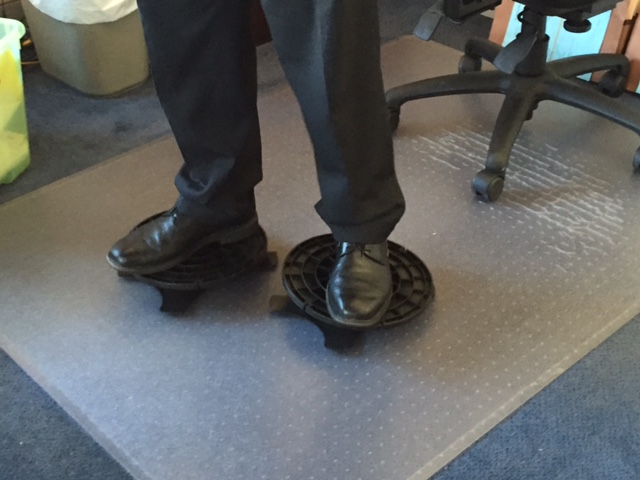
From January to mid-April of each year, accountants and CPAs experience grueling work schedules because of the federal income tax return deadline. It’s “goodbye” to a normal eight-hour workday and “hello” to 12 to 14 hour work days – for months!
During this time, CPAs run the daily risk of sitting at their desks, being sedentary for too many hours.
Corey Duncan, a principal at TGM Group, one of the larger locally-owned accounting firms on Delmarva, has suffered from spinal stenosis for a very long time. After years of trying different chairs and other back supports that didn’t work, his search to find relief from the long hours of sitting led him to a “sit-to-stand desk.” As the name suggest, sit-to-stand desks are adjustable desks that can be elevated to allow a worker to stand whilst working and lower back down when they are ready to sit again.
These novel desks have recently become popular after research indicated that sitting for long periods of time increased risk for obesity, high blood pressure, high cholesterol, diabetes, cancer, depression, and cardiovascular disease. In fact, according to Mayo Clinic, excess amounts of sitting can lead to a 125 percent increased risk of events associated with cardiovascular disease.
Corey’s uncle, an experienced physical therapist in Lynchburg, Virginia, told Corey that he would find back relief by using one of these special desks. Corey purchased one of the desks from their trusted contract furniture vendor, WB Mason Interiors this past fall. He immediately noticed a difference. On average he rotates between sitting and standing during one-hour intervals. He said, “When you think of working an eight-hour day, it is like flying to England every day in an uncomfortable airline seat. You can appreciate what we put our bodies and backs through daily while at work sitting.” Corey also incorporates the use of “wobble boards” (see below photo) when he stands to help maintain a strong core to help with his bad back. He also uses a phone headset to prevent his neck being in an uncomfortable position for long periods of time while talking on the phone to clients.
After Corey’s rave reviews of his sit-to-stand desk, his colleague Craig Walter – another principal at TGM Group – ordered a similar desk for his office at the beginning of the tax season this past January.
This is the first tax season for both of the CPAs using a sit-to-stand desk. They say that the investments in the desk have been worth their weight in gold.

The sit-to-stand desk functions by pushing a button located underneath the top of the desk. Once pushed, the surface of the desk raises (or lowers) via pistons that function as part of the desk’s legs.
In addition to the physical health benefits of his sit-to-stand desk, Craig says that the cycle of sitting and standing throughout the day also gives him a different perspective with respect to his work. He also has seen a noticeable difference with his ability to concentrate for longer periods of time.
Both Craig and Corey like the aesthetics and functionality of their desks as well.
It is certainly clear that standing at times is better for the body than sitting, and Corey and Craig can attest to this. So the next time you are sitting at your desk at work feeling groggy, uncomfortable or tired, simply think to yourself, “Just how long have I been sitting and how is this affecting my well-being?” Sit-to-stand desks can lead to a positive shift in workers moods, increased health quality and an overall increase in worker productivity and well-being.

